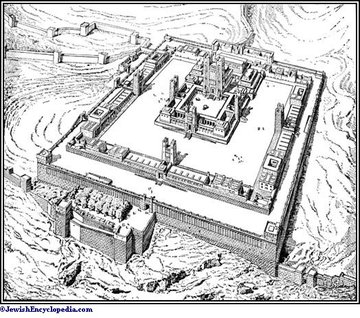Second Temple
|
|
The Second Temple was the reconstructed Temple in Jerusalem which stood between 515 BCE and 70 CE. During this time, it was the center of Jewish worship, which focused on the sacrifices known as the korbanot. Solomon's Temple, also known as the First Temple, was destroyed in 586 BCE when the Jews were exiled into the Babylonian Captivity. The Romans destroyed Jerusalem and its Second Temple circa 73 CE, ending the Great Jewish Revolt that began in 66 CE.
| Contents |
Nation reorganized
After the return from captivity, under Zerubbabel and the high priest Jeshua, arrangements were almost immediately made to reorganize the desolated Kingdom of Judah after its demise seventy years earlier. The body of pilgrims, forming a band of 42,360 including children, having completed the long and dreary journey of some four months, from the banks of the Euphrates to Jerusalem, were animated in all their proceedings by a strong religious impulse, and therefore one of their first concerns was to restore their ancient house of worship by rebuilding their destroyed temple and reinstituting the sacrificial rituals known as the korbanot ("sacrifices" in Hebrew).
On the invitation of Zerubbabel, the governor, who showed them a remarkable example of liberality by contributing personally 1,000 golden darics, besides other gifts, the people with poured their gifts into the sacred treasury with great enthusiasm (Ezra 2). First they erected and dedicated the altar of God on the exact spot where it had formerly stood, and they then cleared away the charred heaps of debris which occupied the site of the old temple; and in the second month of the second year (535 BCE), amid great public excitement and rejoicing (befitting Psalms 116; 117; 118), the foundations of the second temple were laid. A wide interest was felt in this great movement, although it was regarded with mingled feelings by the spectators (Haggai 2:3; Zechariah 4:10).
Samaritans offer
The Samaritans made proposals for co-operation in the work. Zerubbabel and Jeshua and the elders, however, declined all such cooperation, feeling that Judea must build the temple without help. Immediately evil reports were spread regarding the Jews. According to Ezra 4:5, the Samaritans sought to "frustrate their purpose" and sent messengers to Ecbatana and Susa, with the result that the work was suspended.
Monarchs
Seven years after this Cyrus the Great died ingloriously, having killed himself in Syria on his way back from Ancient Egypt to the east, and was succeeded by his son Cambyses, on whose death the "false Smerdis," an imposter, occupied the throne for some seven or eight months, and then Darius I of Persia became king (522 BCE). In the second year of this monarch the work of rebuilding the temple was resumed and carried forward to its completion (Ezra 5: 6-17; 6:1-15), under the stimulus of the earnest counsels and admonitions of the prophets Haggai and Zechariah. It was ready for consecration in the spring of 515 BCE, more than twenty years after the return from captivity.
Missing articles
This second temple was missing the Ark of the Covenant, the Urim and Thummim, the holy oil, the sacred fire, the Ten Commandments, the pot of manna, and Aaron's rod. As in the Tabernacle, there was in it only one golden lamp for the holy place, one table of shewbread, and the incense altar, with golden censers, and many of the vessels of gold that had belonged to Solomon's Temple that had been carried to Babylon but restored by Cyrus (Ezra 1:7-11).
This second temple also differed from the first in that, while in the latter there were numerous "trees planted in the courts of the Lord," there were none in the former. The second temple also had for the first time a space, being a part of the outer court, provided for proselytes who were worshippers of God, although not subject to the laws of Judaism.
Completion
Second_Temple_Destroyed.jpg
The temple, when completed, was consecrated and the sacrificial observances known as the korbanot were commenced once again, amid great rejoicings on the part of all the people (Ezra 6:16), although it was evident that the Jews were no longer an independent people, but were subject to a foreign power. The Book of Haggai records a prediction (2:9) that the glory of the second temple would be greater than that of the first. This temple, during the different periods of its existence, is often regarded by believers as but one house, the one only house of God.
Christian views
Many Christians argue that the glory here predicted is spiritual glory and not material splendor, in that Jesus would be present during his life at the second temple.

